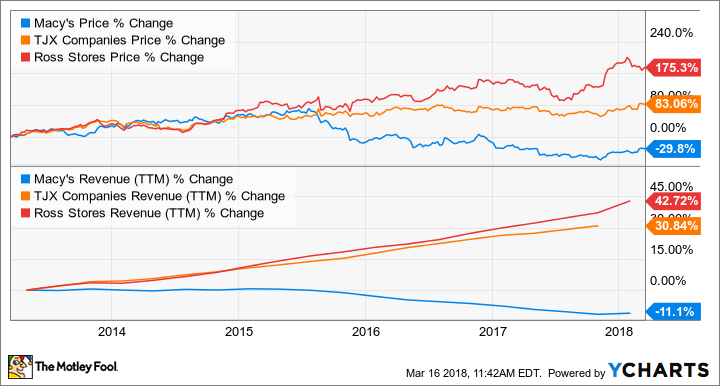Is Macy's Ready to Give Up on Traditional Department Stores?
During its fourth-quarter earnings call, Macy's (NYSE: M) expounded on plans to rebound from what has been a rough multi-year stretch.
The traditional department store business model has struggled while off-price discounters like TJX Companies and Ross Stores thrive. Buried in management's comments was a big hint that off-price could actually be the future of this industry.
Data by YCharts. TTM = Trailing 12 months.
What Macy's is doing
In light of the mass migration to online shopping, it's no surprise that Macy's has been giving a lot of attention to its online store as well. Digital shopping isn't the only segment of retail that's been growing, though. CEO Jeffrey Gennette recently said this about the new area of focus:
In 2017, we expanded Macy's Backstage, our on-model off-price offering, to 45 stores. We saw a lift in performance of almost seven full points per store and we believe there is more upside. We feel good about the model that we've landed on for Backstage. And in 2018, we're planning to expand by another 100 stores, including locations in some of our premium malls.
Backstage is Macy's off-price retail experience often described as a treasure hunt. There is no set inventory -- the assortment is typically leftover Macy's merchandise discounted as much as 80%. Shoppers could compare Backstage to the TJ Maxx, Marshalls, and Ross off-retail format. A subtle difference from competitors, though, is that Backstage is located within existing Macy's locations.
The new concept is gaining traction with the number of locations set to triple in 2018. With over 690 department stores at the end of 2017, that means over 20% of Macy's locations will have a Backstage by the end of this year.

Image source: Getty Images.
If this works ...
Macy's is monitoring the success of Backstage, and management says the data it has collected looks promising. Inserting a discount store within a full-price environment seems counterintuitive. But rather than cannibalizing sales from the full-price portion of its store, management said Backstage is attracting new customers to Macy's and increasing the average purchase size per shopper. In light of that, Backstage will begin testing in some of Macy's flagship "premium" locations as well.
The department store chain has been aggressively closing down brick-and-mortar locations as it transitions to more digital sales in recent years. In 2016, the company announced the closure of 100 underperforming stores over the course of a few years -- at the time 15% of its total footprint. To bolster stores that remain, management is targeting 40% of its sales coming from Macy's exclusive brands and merchandise from product partners, up from about 29% now.
That means that Backstage would offer a different shopping experience from those it's imitating. Most off-price retailers source their merchandise from leftovers in the retail industry. If 40% of Macy's inventory is exclusive, that means shoppers would have an incentive to shop Backstage for deals.
The Backstage expansion could be indicative of a permanent shift in the world of retail. Full-price sales -- and especially unique merchandise -- are quickly migrating to an online direct-to-consumer format. Leftovers are getting sent to treasure hunt brick-and-mortar stores where bargain-hungry shoppers thrive. If Macy's keeps up this pace, it could spell trouble for other department stores that are still lagging behind the new retail reality.
More From The Motley Fool
Nicholas Rossolillo has no position in any of the stocks mentioned. The Motley Fool recommends The TJX Companies. The Motley Fool has a disclosure policy.

